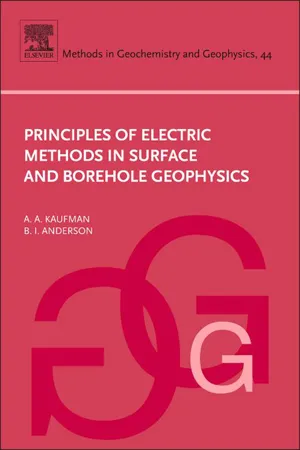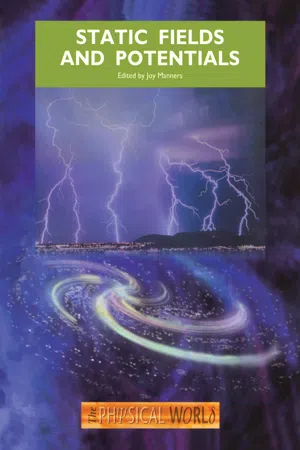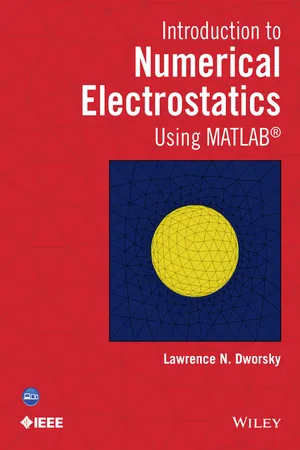Physics
Equipotential Lines
Equipotential lines are imaginary lines in a field where the potential at every point is the same. In physics, specifically in the context of electric fields, equipotential lines are perpendicular to the electric field lines. They are used to visualize and understand the distribution of electric potential in a given space.
Written by Perlego with AI-assistance
Related key terms
8 Key excerpts on "Equipotential Lines"
- No longer available |Learn more
- Robert A. Pelcovits, Joshua Farkas(Authors)
- 2023(Publication Date)
- Barrons Educational Services(Publisher)
Although potential exists in three dimensions, we will only try to describe the potential along a plane. Potential is a scalar, so it assigns a value to every point in the plane. Thus, one way to visualize potential along a plane is simply to make a three-dimensional plot with two position dimensions and a potential dimension. Such a plot might look a bit like a landscape, with conical “mountains” extending to infinite heights over positive point charges or equally deep conical “craters” extending below negative point charges.Alternatively we can represent potential in two dimensions using Equipotential Lines, which are lines of constant potential in the two-dimensional plane. By providing a series of Equipotential Lines at equally spaced intervals (i.e., plotting when potential is 1 V, 2 V, 3 V, and so on), a contour plot can be created (similar to topographical maps that display different altitudes in different colors). Some properties of Equipotential Lines are the following.1.Because the potential is the same along an equipotential line, no force or work is required to move a charge along a given equipotential line.2.Recall that work is defined as W = F · dr. Thus, the fact that no work is required to move a charge along an equipotential line reveals that the line must be perpendicular to the electric force and thus perpendicular to the electric field.3.As discussed above, along a line joining any two points in space, Eparallel to line = −dV/d(position). We can use this equation to estimate the electric field from Equipotential Lines: Because we know from property 2 that the field is perpendicular to the Equipotential Lines, for any line segment perpendicular to the Equipotential Lines, E = Eparallel to line ≈ −ΔV/Δ(position). Qualitatively, this equation shows that the electric field is stronger (and thus the electric field lines are bunched closer together) in regions where the potential changes rapidly (which corresponds to regions where Equipotential Lines are spaced closely together). Some examples of electric field lines and equipotential curves are shown in Figure 10.4 - eBook - ePub
- Sivaji Chakravorti(Author)
- 2017(Publication Date)
- CRC Press(Publisher)
non-uniform field . In the case of three-dimensional systems, such equipotentials will be surfaces.FIGURE 1.8 Examples of equipotentials: (a) uniform field and (b) non-uniform field.FIGURE 1.9 Equipotential vis-à-vis electric fieldline.1.7.1 Equipotential vis-à-vis Electric Fieldline
Consider an equipotential of any electric field, as shown in Figure 1.9 . At any point P on this equipotential, consider that the electric fieldline makes an angle θ with the tangent to the equipotential at that point. If an elementary length dl is considered along the equipotential at P , then the potential difference between the two extremities of dl will be given by. But if dl lies on the equipotential, then there should not be any potential difference across dl . Again, the magnitude of electric field intensity is not zero at P and dl is also a non-zero quantity. Hence, the potential difference across dl could only be zero if cos θ is zero (i.e. if θ is 90°).|d l cos θE →|Thus, a basic constraint of electric field distribution is that the electric field-lines are always normal to the equipotential surface. A practical example of this constraint is that the electric fieldlines will always leave or enter conductor surfaces at 90°. This criterion is often used to check the accuracy of electric field computation by numerical techniques. The other properties of equipotential are (1) the tangential component of the electric field along the equipotential is zero and (2) no work is required to move a charged particle along an equipotential.1.7.2 Electric Potential of the Earth Surface
The electric potential of the Earth surface could be determined with the help of the discussion in Section 1.7.1 - Alex Kaufman, B. Anderson(Authors)
- 2010(Publication Date)
- Elsevier Science(Publisher)
Then, the Equipotential Lines again tend to circles. It happens because at great distances, the potential of the two charges behaves as that of the single charge 2 e placed at the origin. At the point (x = 0, y = 0, z = 0) the electric field is equal to zero, that is, grad U = 0. This is actually a “saddle point” of the potential, where it increases in the two directions along the x -axis going toward the charges, but decreases in opposite directions pointing along the y -axis. By drawing lines perpendicular to the Equipotential Lines, or solving Eq. [1.99], we obtain the family of the vector lines of the field E (Fig. 1.8C). All vectors lines start from charges, while the other terminal points are located at infinity. It is useful to notice that in the vicinity of the plane x = 0 and not far from the origin the vector lines are almost parallel to this plane. Such “focusing” of the field due to the presence of two charges is often used in borehole geophysics. Figure 1.8D shows the behavior of the potential and electric field caused by charges of equal magnitude and opposite sign. In this case, each vector line has the same terminal points, x = ± a, and everywhere grad U ≠ 0 ; that is, the field is regular at all points except at the two point charges. 1.12.4 Behavior of Potential U and Field E far away from Charges Suppose that a point of observation p is far away from charges distributed in some volume V with density δ (q). This means that distances L qp from the point p to any point q of the volume is nearly constant. Correspondingly, Eq. [1.90] can be written as U (p) = 1 4 π ε 0 L qp ∫ V δ (q) d V = e 4 π ε 0 L qp if L qp → ∞. [1.107] Here q is any point inside of the volume and e is total charge- eBook - ePub
- Joy Manners(Author)
- 2020(Publication Date)
- CRC Press(Publisher)
Contours on a map are lines drawn where the equipotential planes and the land surface intersect. These horizontal planes are, of course, really small parts of huge spheres centred on the centre of the Earth, which, like electric equipotentials around a point charge, grow more widely spaced with distance from the Earth (see Figure 2.15). On this large scale, the gravitational field is directed radially towards the centre of the Earth, and its magnitude decreases with increasing r. Figure 2.15 Gravitational equipotentials around the Earth are concentric spheres with increasing spacing. On the smaller scale of everyday life near the surface of the Earth, these concentric spheres approximate to equally spaced planes. Question 2.14 Large electric fields can be dangerous. When lightning strikes a tree, the electric potential of the tree trunk may be 1 million volts with respect to the zero of potential which is taken to be at infinity. It has been observed that if a cow takes shelter under a tree during a thunderstorm, it is more likely to be killed if it is standing along the line of a radius to the tree than if it is standing sideways on to the tree. Why is this? (Hint: Imagine looking down on the situation from above. Draw in a set of equipotentials round the tree trunk; then put one cow in the radial direction, and one cow in a sideways direction.) Question 2.15 Figure 2.16 shows the electric Equipotential Lines between two parallel charged plates. Sketch on the figure the field lines both in the central region and at the edges of the plates. What can be said about the strength of the field in each region? ■ Figure 2.16 For use with Question 2.15. 3.4 Electrostatic screening So far in this chapter, we have been concerned with the variation of the potential in the neighbourhood of charges situated in free space - eBook - ePub
- A. L. Stanford, J. M. Tanner(Authors)
- 2014(Publication Date)
- Academic Press(Publisher)
x axis.We may determine the electric field componentExfrom the given potential V using Equation (13-25) :Then the required electric field isE x= −= −d Vd xdd x[k λ ln](x)x − LE x=k λ Lx(x − L)E =(13-26)k λ Lx(x − L)i ˆ(13-26)13.4 Equipotential Surfaces and Charged Conductors
Any surface along which the electric potential has a constant value is called an equipotential surface . Equation (13-6) , dV = −E · ds , requires that for a displacement ds along an equipotential surface, where dV = 0, the electric field E is perpendicular to the displacement, so that E · ds = 0. Therefore, the electric field at any point is perpendicular to the equipotential surface passing through that point.The relationship between an electric field and its corresponding equipotential surfaces is conventionally pictured in diagrams like those of Figure 13.10 , a point charge and an electric dipole. In this figure the electric field (solid lines) and equipotential surfaces (dashed lines) are displayed in a cross-sectional plane passing through all points on an axis of symmetry. For charge distributions with axes of symmetry, the equipotential surfaces are those surfaces of revolution generated by rotating the dashed lines about an axis of symmetry. Notice that the equipotential surfaces are perpendicular to the electric field lines at every point.Figure 13.10 Representations of electric fields (solid lines) and equipotential surfaces (dashed lines) for a positive point charge and an electric dipole. The equipotential surfaces are perpendicular to the lines of electric field at every point.The surface of a charged conductor is an equipotential surface, because the electric field immediately outside the surface is perpendicular to that surface. Inside a conducting material, where the electric field E is identically equal to zero, the change (dV = −E · ds - eBook - ePub
Molecular Driving Forces
Statistical Thermodynamics in Biology, Chemistry, Physics, and Nanoscience
- Ken Dill, Sarina Bromberg(Authors)
- 2010(Publication Date)
- Garland Science(Publisher)
E.The Equipotential Surfaces Around Two Positive Point ChargesFigure 21.3 Lines of equal electrostatic potential around two positive point charges.The dashed lines in Figure 21.3 show the electric field E in the (x,y) plane due to two charges of the same sign: q at x = -ℓ/2, and q at x = +ℓ/2. The x axis is an axis of symmetry of this electric field and charge constellation. The solid curves indicate the intersection of the plane of the page and the equipotential surfaces. If you rotate the solid curves about the x axis, out of the plane of the page, you generate the full three-dimensional equipotential surfaces. The equipotential surfaces become more nearly perfect spheres as their distance from the charges increases. Therefore, at a distance far away from the point charges, you can view the electrostatic potential as though it were due to a single point charge equal to 2q at x = 0.Figure 21.4 The same amount of work is required to move a charge from point A to D to C as from point A to B to C, because work is done only in the radial steps.Electrostatic Interactions Are Conservative ForcesThe reversible electrostatic work is a path-independent quantity that sums to zero around a cycle. Figure 21.4 shows two different pathways for moving a charge q2 from point A to point C in the field of a single point charge q1 . Path 1 is from A to B to C. Path 2 is from A to D to C. Moving a particle along circumference segments AB and DC involves no work because there is no change in radius. Both radial segments, AD and BC, involve the same change in radius, so the reversible work in moving a charge along either pathway ABC or ADC is the same:Figure 21.5 Even with an array as complex as the charges in the protein superoxide dismutase (gray), no work is done in moving a charge in a cycle. One such cycle is shown by the heavy line. Dotted lines are equipotential contours. Source: I Klapper, R Hagstrom, R Fine, et al., Proteins: Structure, Function and Genetics 1 - eBook - ePub
Dielectrophoresis
Theory, Methodology and Biological Applications
- Ronald R. Pethig(Author)
- 2017(Publication Date)
- Wiley(Publisher)
equipotential surfaces and electric field lines are always mutually orthogonal.Figure 4.6A cross-section is shown of the equipotential surfaces (−8 V, −6 V, −4 V and −2 V) around a spherical electrode of radius 20 μm, electrified to a potential of −10 V with respect to a zero reference at infinity. The radial field lines E intersect the spherical equipotential surfaces at right angles.Example 4.6 Relationship between Electrode Surface Charge Density and the Potential Difference between Parallel ElectrodesDerive an expression that relates the charge density per unit area on parallel electrodes, of the form shown in Figure 4.2 , to potential difference between the electrodes. Assume that the width of the electrodes is much greater than the distance d between them, so that the field generated between them can be considered uniform.Solution 4.6 The work Wx done by the field E in moving a test charge q from the cathode to a location x above the cathode is given by:From Box 4.1 this work done is equal to the negative of the change in potential energy U, so that:where Uc is the potential at the cathode. The potential V at any location is the potential energy per unit charge, so that:When the distance x is equal to the distance d between the cathode and the anode, Vx is the potential Va at the anode, so that:The electric field between parallel electrodes is thus equal to the potential difference between the electrodes divided by the distance between them:(4.24)From Equation (3.21) of Chapter 3, the field in the dielectric between two parallel electrodes is:where σ is the charge per unit area on the anode (or −σ on the cathode). From Equation (4.24 - Lawrence N. Dworsky(Author)
- 2014(Publication Date)
- Wiley-IEEE Press(Publisher)
1.28 ) is a scalar equation, which is almost always easier to work with than is a vector equation. Also, once the voltage is known, it is a straightforward job to calculate the field. Consequently, we will concentrate on finding voltages and then (if necessary) finding the field, not the other way around.For the single-point charge of equation (1.28 ), we already know that the field lines point radially outward (from the charge), going to infinity. Figure 1.9 . shows surfaces of constant potential, known as equipotential surfaces or more commonly equipotentials. These surfaces cross the field lines normally and in this situation are spheres.Electric field lines and equipotential surfaces about a point charge.FIGURE 1.9If, instead of a single charge q, we have a collection of (discrete) charges, we must replace equation (1.28 ) by the sum of the contributions of all the charges, and a is replaced by the distances from each of the charges (xi ,yi ,zi ) to the measurement point p = (xp ,yp ,zp ). In other words,(1.29)and then(1.30)The gradient [equation (1.26 )] operating on V produces en electric field vector whose direction is the same as that of the maximum change in V. Since the direction of maximum change from an equipotential contour is always normal to the contour, the electric field lines will always be normal to the equipotential contours. Figure 1.10 is essentially a repeat of Figure 1.1
Index pages curate the most relevant extracts from our library of academic textbooks. They’ve been created using an in-house natural language model (NLM), each adding context and meaning to key research topics.







